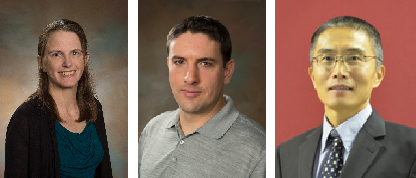Texas A&M Galveston Researchers Receive Grants to Study the Effects of Hurricane Harvey
October 10, 2017
Tweet
Texas A&M University at Galveston National Science Foundation award recipients, Drs. Anna Armitage, Jens Figlus and Hui Liu.
By Patrick Temperilli, Academic Affairs and Bob Wright, Marketing and Communications
The National Science Foundation (NSF) recently announced awards totaling more than $1.2 million to support 13 research projects throughout the Texas A&M University System whose aim is to understand the effects of natural disasters like Hurricane Harvey. Researchers at Texas A&M University at Galveston received three of these awards.
In all, the NSF announced 59 new grants totaling $5.3 million for hurricane-related research. The Texas A&M System’s projects represented about 22 percent of those grants and they received about 23 percent of the funding. “In the aftermath of Harvey, the Texas A&M System has stepped up to aid in the recovery and rebuilding of our state in unprecedented and inspiring ways,” said A&M System Chancellor John Sharp. “I am proud that our researchers are hard at work helping us better understand and prepare for the next storm, and I’m grateful to the NSF for supporting these efforts.”
The funded projects cover a variety of research areas, including the hurricane’s impact on water quality, human-robotic interactions during the recovery process, a natural disaster’s effects on food distribution, the use of unmanned aerial systems during hurricane response and strategies to provide better coastal protection, among others.
“NSF-funded scientists have a long history of advancing our understanding of large-scale disasters and their aftermath,” says NSF Director France Córdova. “These researchers have increased our ability to predict the paths of tropical cyclones, found ways of improving flood water decontamination and enhanced our understanding of the mechanisms that may cause levee failures. NSF’s new awards will result in similar advances critically needed in the face of such disasters.”
The following Texas A&M Galveston researchers were awarded grants:
Dr. Anna Armitage - researching whether mangroves provide better coastal protection than salt marshes. “Hurricane Harvey provided a unique opportunity to answer a critical question: Do mangroves provide fundamentally different – or better – shoreline protection than the grasses and shrubs that they replace?” asked Armitage. “Mangroves are often assumed to be more resilient to erosion and to be better able to protect shorelines, relative to marsh plants, but this has not been tested on the Texas coast, where mangroves are relatively small.”
Dr. Jens Figlus - researching how Hurricane Harvey impacted barrier islands and document recovery of the barrier system following the hurricane. Although a faculty member at Texas A&M Galveston, this grant comes through the Texas A&M Engineering Experiment Station. “We will analyze recorded field data on storm surge, wave impact, erosion and accretion at several of our field sites, and continue to monitor the locations over the next year to track post-storm changes,” said Figlus. “This will help us better understand how our coastal system reacts to extreme events and in turn, this knowledge can help bolster the resiliency of coastal communities.”
Dr. Hui Liu - researching the impact of hurricane-induced heavy rainfall and extreme flooding on the near-term impacts on the animal life in the Galveston Bay watershed and its restoration in the aftermath of the hurricane. “We want to generate post-storm data on the abundance, composition and distribution of zooplankton,” said Hui. “This data will allow examination of zooplankton distribution, evaluate the impacts of hurricane induced extreme flooding on zooplankton community dynamics in terms of ecosystem restoration and engage undergraduate students and the local community through citizen science and communication providing valuable information on estuarine ecosystems.”
Other Texas A&M System entities receiving grants include Texas A&M University, Texas A&M Engineering Experiment Station, Texas A&M University-Corpus Christi and West Texas A&M University.
###
Media contact:Patrick Temperilli, Academic Affairs
temperilli@tamug.edu 409.740.4783
Bob Wright, Marketing and Communications
wrightb@tamug.edu 409.740.4840
More:
Health & Environment
Marine Biology
Marine Engineering Technology